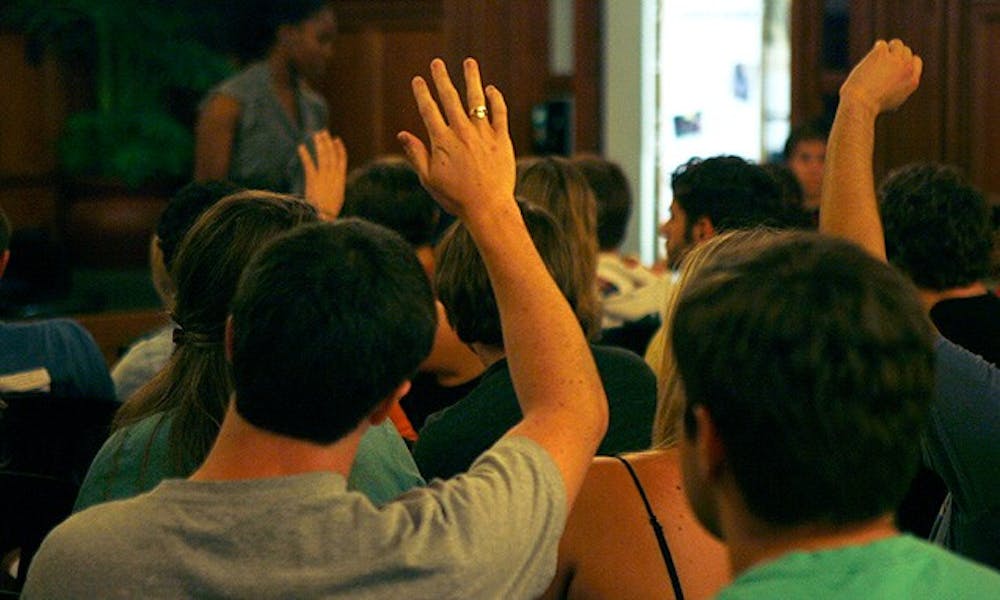Duke Student Government held a forum in the Great Hall Tuesday to address student questions and concerns about the new house model to be implemented Fall 2012.
The new system will house affiliated students and randomly place independents across 74 houses–53 on West Campus and 21 on Central Campus. The forum, which was attended by approximately 40 students, featured a PowerPoint presentation to explain the specifics of the new residential system and invited students to voice their concerns.
“When you ask people who lived through the old house model, they respond that they have a sense of community to their house and to Duke,” said senior Esosa Osa, DSG vice president for residence life and dining.
The current residential model—the quadrangle model—has been in effect since 2002. Prior to that, Duke had operated under a house model with small communities across East and West Campuses. The University shifted to the quadrangle model largely due to the decision to make East freshman-only, when the administration had difficulty reconciling how to maintain a deteriorating house model and a exclusively first-year campus.
The goals of the house model are creating community and providing residential equality to students, said Joe Gonzalez, associate dean for residence life. Two-thirds of the houses will contain 30 to 70 beds, he said, adding that he believes smaller houses will forge stronger communities. Independents will be placed into a house randomly, at least in the first year of the model.
Under the new model, fraternities and selective living groups will be assigned to locations selected by the House Model Committee—a group of faculty members and students. The new locations—divided into residential clusters based on size and recruitment needs—will be randomly determined in October with the option for each group to indicate preference for Central Campus.
The system is intended to create house-identities in the future, Osa said. Once this occurs, houses can apply to formally become a selective living group with the power to choose its own members.
Students, however, questioned the amount of student input taken into consideration by administrators.
Vice President for Student Affairs Larry Moneta said the implementation of the house model is an institutional decision, which consulted students but is similar to graduation requirements or the core curriculum.
“The core decision to migrate into the house model is a University decision,” he said. “It is not to say that there isn’t room for student input, but this isn’t a consumer-driven decision.”
Administrators said they acknowledged that though the original house model did promote house unity, it fell short in creating camaraderie between individual classes. The house model stipulates that each house—including selective living groups— has a ratio of 50 percent sophomores and 50 percent juniors and seniors. Additionally, independents will not be allowed to block with more than 6 other individuals.
“It’s been clear to us that a model that is predicted on enabling underclassmen contact with upperclassmen is preferred,” Moneta said. “Integration of classes within houses is key for success.”
Some students were concerned about the impact the house model will have on their residential experiences.
Sophomore Caroline Lowe said she felt her voice as an independent was not taken into consideration, especially regarding the random placement of unaffiliated sophomores and juniors.
Matt Lyes, a sophomore in the Sigma Chi fraternity, said he was frustrated at the model’s class ratio.
“Why are they so hell-bent on filling quotas instead of focusing on the guiding principle of the fraternity or SLG?” Lyes said.
Moneta added that the new house model is here to stay.
As part of the house model, groups that currently do not have designated housing can apply for their own space, Osa said. Applications are due September 30, with groups submitting their proposals to the Approval Removal Committee in early October.
“Whether or not your house gets approved depends on how [strongly] we feel it benefits the Duke community,” she said.
In order to achieve this goal, Gonzalez said the model is encouraging seniors to stay on campus by allowing them to select their location next fall. He added, however, that houses will still have limits as to how many seniors can live there and expects 20 percent of seniors to live on campus under the new house model.
Audience members expressed concerns that fraternities and selective living groups would no longer be held accountable by their Residential Group Assessment Committee evaluations. The decision to refrain from using RGAC scores for placement was implemented prior to any house model discussions, Gonzalez said.
“The ability to take away space or punishment is not part of the house model,” Osa said.
The house model, however, remains a work in progress, and there are still unresolved issues, Gonzalez said. The placement of junior’s returning from study abroad programs is still being debated—one proposal on the table involves the creation of a junior village for returning students to live in as a class.
“We don’t consider the [model this] first year to be the final form,” he noted.
Get The Chronicle straight to your inbox
Signup for our weekly newsletter. Cancel at any time.

